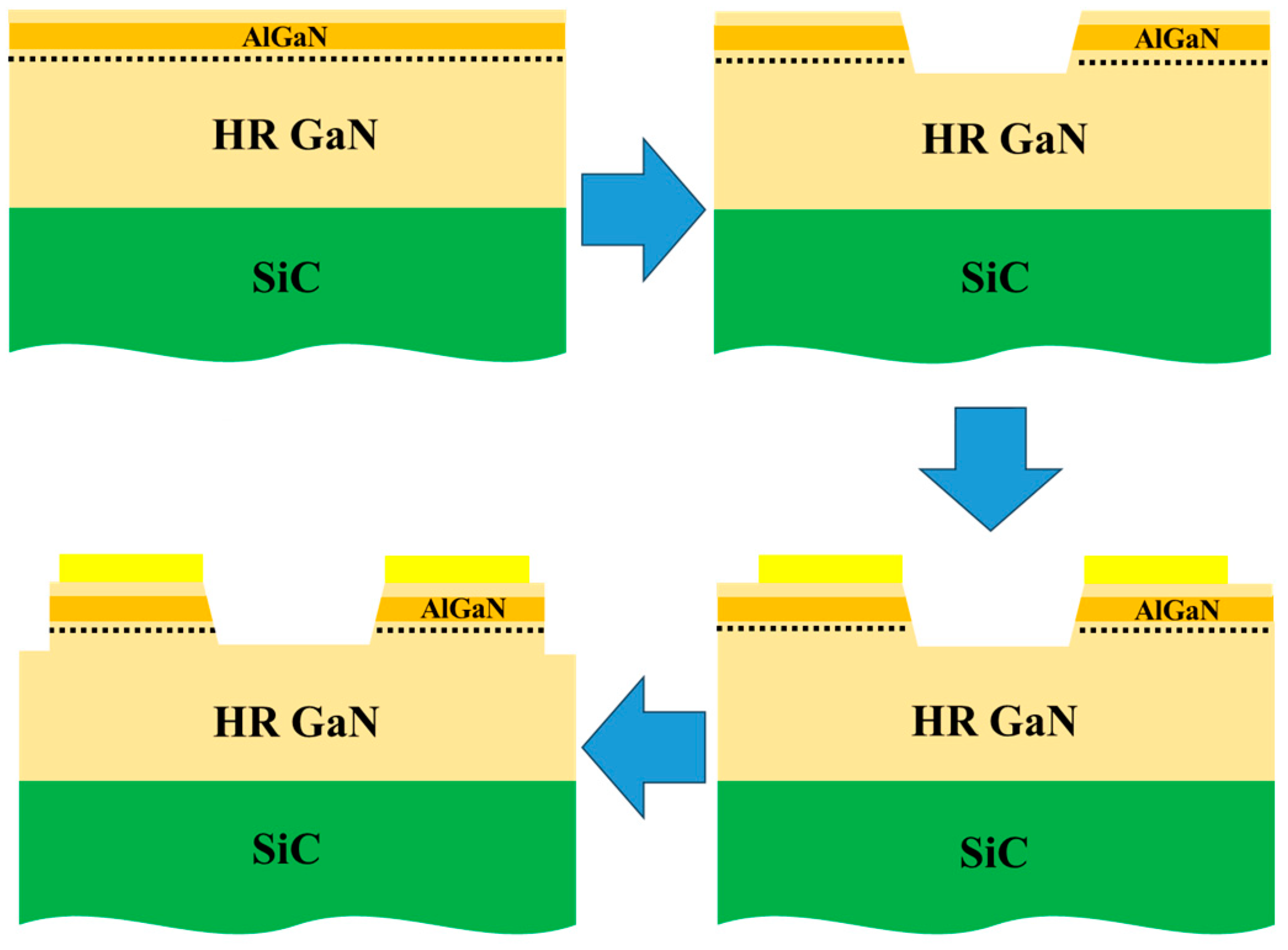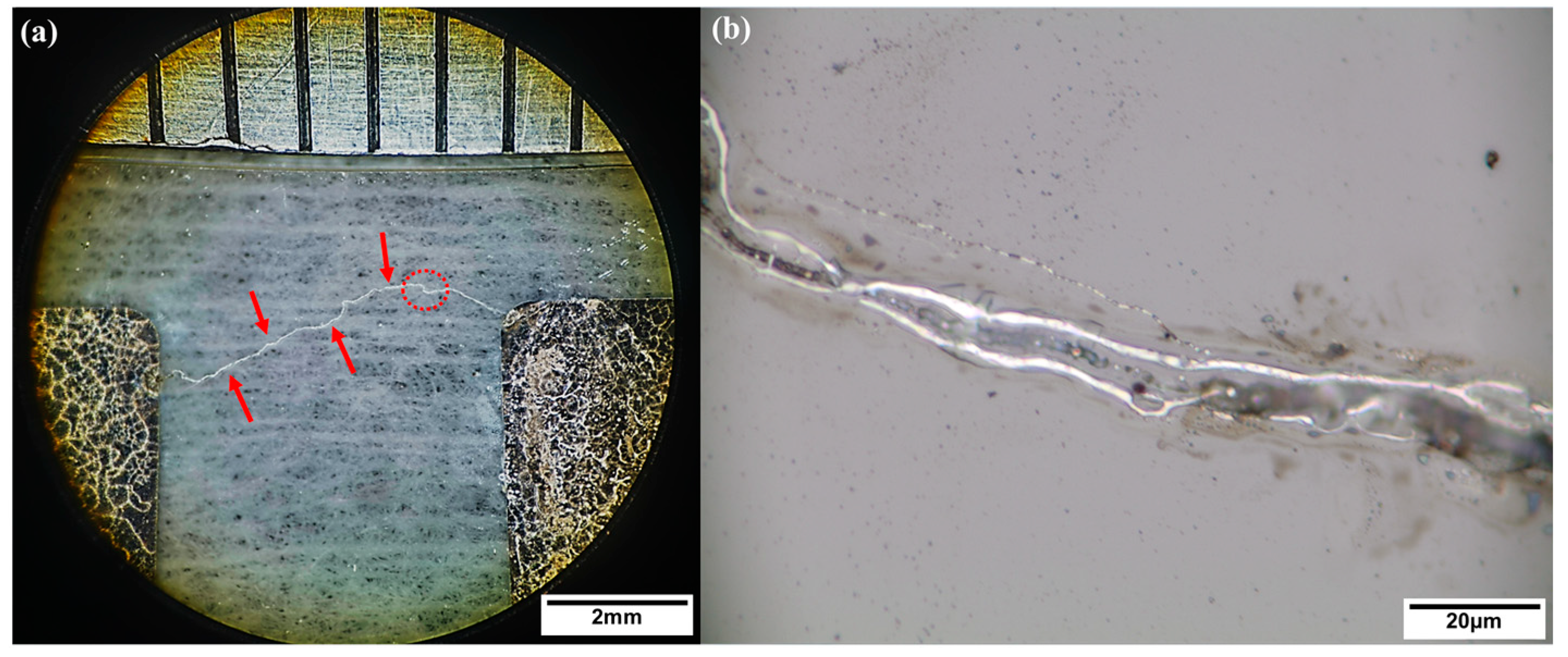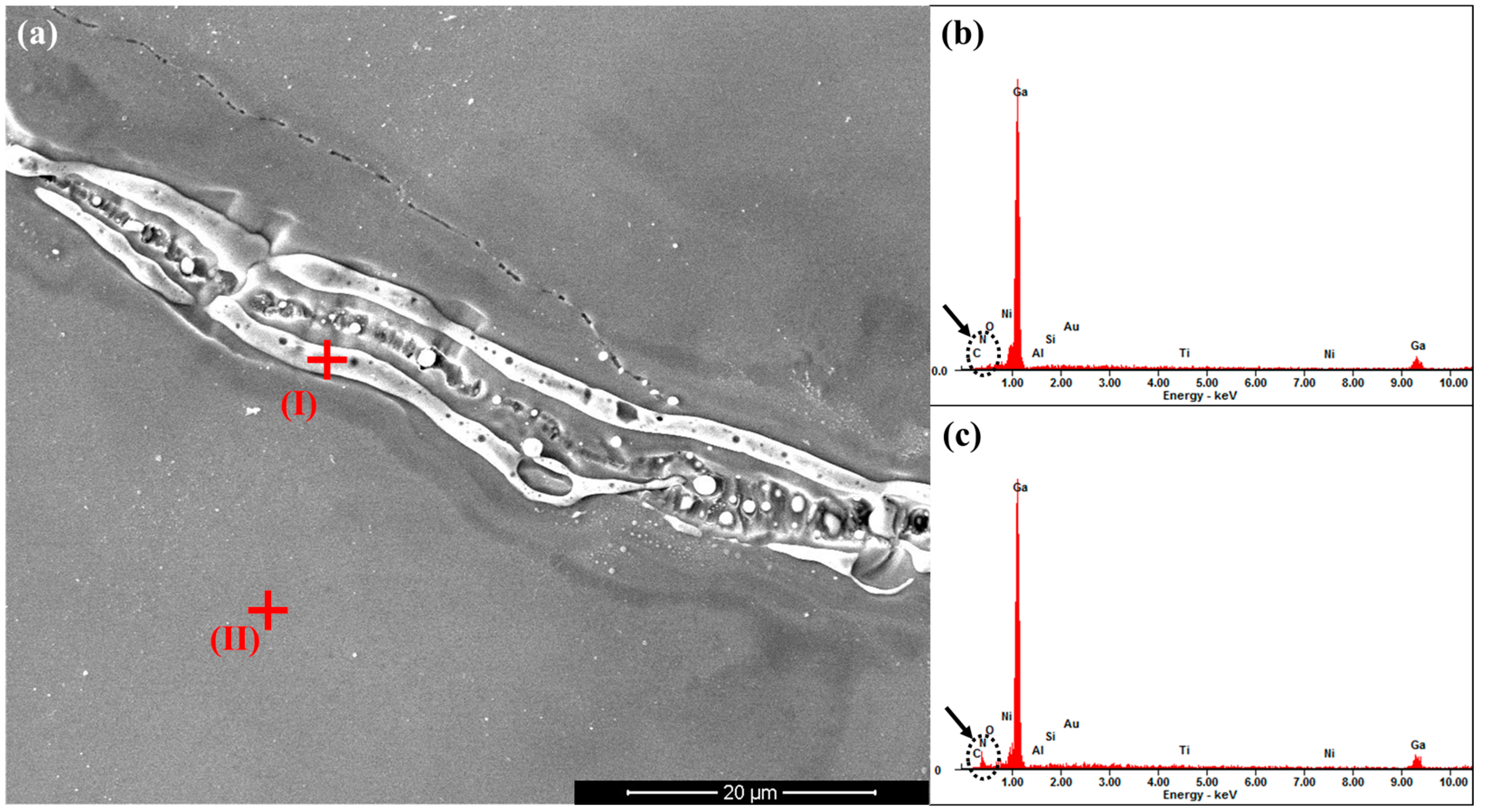Properties Investigation and Damage Analysis of GaN Photoconductive Semiconductor Switch Based on SiC Substrate
Abstract
1. Introduction
2. Experiments
3. Results and Discussion
4. Conclusions
Author Contributions
Funding
Data Availability Statement
Conflicts of Interest
References
- Sullivan, J.S.; Stanley, J.R. Wide Bandgap Extrinsic Photoconductive Switches. IEEE Trans. Plasma Sci. 2008, 36, 2528. [Google Scholar] [CrossRef]
- Mazzola, M.S.; Schoenbach, K.H.; Lakdawala, V.K.; Germer, R. GaAs photoconductive closing switches with high dark resistance and microsecond conductivity decay. Appl. Phys. Lett. 1989, 54, 742. [Google Scholar] [CrossRef][Green Version]
- Zutavern, F.J.; Loubriel, G.M.; Helgeson, W.D.; O’Malley, M.W.; Gallegos, R.R.; Hjalmarson, H.P.; Baca, A.G.; Plut, T.A. High-gain GaAs photoconductive semiconductor switches PCSS device lifetime high-current testing optical pulse generators. In Optically Activated Switching IV; SPIE: Boston, MA, USA, 1994. [Google Scholar] [CrossRef]
- Wu, T.; Shang, B.; Vorst, A.V. A high speed silicon photoconductive switch. Microw. Opt. Technol. Lett. 1996, 11, 177. [Google Scholar] [CrossRef]
- Liu, T.A.; Lin, G.R.; Lee, Y.C.; Wang, S.C.; Tani, M.; Wu, H.H.; Pan, C.L. Dark current and trailing-edge suppression in ultrafast photoconductive switches and terahertz spiral antennas fabricated on multienergy arsenic-ion-implanted GaAs. J. Appl. Phys. 2005, 98, 013711. [Google Scholar] [CrossRef]
- Liu, Y.; Shen, Y.; Wang, W.; Xia, L.; Ye, M.; Zhang, H.; Shi, J.; Deng, J. Solid-state pulsed power system with GaAs-PCSS for DWA. In Proceedings of the IEEE 21st International Conference on Pulsed Power, Brighton, UK, 18–22 June 2017. [Google Scholar] [CrossRef]
- Wu, Q.; Xun, T.; Zhao, Y.; Yang, H.; Huang, W. The test of a high-power semi-insulating linear-mode vertical 6H-SiC PCSS. IEEE Trans. Electron Dev. 2019, 66, 1837. [Google Scholar] [CrossRef]
- Wu, Q.; Zhao, Y.; Xun, T.; Yang, H.; Huang, W. Initial test of optoelectronic high power microwave generation from 6H-SiC photoconductive switch. IEEE Electron Dev. Lett. 2019, 40, 1167. [Google Scholar] [CrossRef]
- Chu, X.; Meng, J.; Wang, H.; Zhu, D.; Yuan, Y.; Huang, L.; Xiang, Z.; Han, J.; Deng, B.; Cui, Y.; et al. Influence of Nitrogen Doping in Vanadium- Compensated 4H-SiC on Transient Photocurrent Response for Photoconductive Microwave Generation. J. IEEE Photonics Technol. Lett. 2024, 36, 531. [Google Scholar] [CrossRef]
- Wang, X.; Mazumder, S.K.; Shi, W. A GaN Based Insulated Gate Photoconductive Semiconductor Switch for Ultrashort High-Power Electric Pulses. IEEE Electron Dev. Lett. 2015, 36, 493. [Google Scholar] [CrossRef]
- Chen, Y.; Lu, H.; Chen, D.; Ren, F.; Zhang, R.; Zheng, Y. High voltage photoconductive semiconductor switches fabricated on semi-insulating HVPE GaN Fe template. Phys. Status Solidi C 2016, 13, 374. [Google Scholar] [CrossRef]
- Shi, D.; Jiang, L.; Wang, Q.; Feng, C.; Xiao, H.; Li, W.; Wang, X. A novel structure to enable low local electric field and high on-state current in GaN photoconductive semiconductor switches. Opti. Commun. 2021, 497, 127133. [Google Scholar] [CrossRef]
- Koehler, A.D.; Anderson, T.J.; Khachatrian, A.; Nath, A.; Tadjer, M.J.; Buchner, S.P.; Hobart, K.D.; Kub, F.J. High voltage GaN lateral photoconductive semiconductor switches. J. Solid State Sci. Technol. 2017, 6, S3099. [Google Scholar] [CrossRef]
- Leach, J.H.; Metzger, R.; Preble, E.A.; Evans, K.R. High voltage bulk GaN-based photoconductive switches for pulsed power applications. In Proceedings of the Gallium Nitride Materials and Devices VIII, San Francisco, CA, USA, 4 March 2013. [Google Scholar] [CrossRef]
- Meyers, V.; Mauch, D.; Kuryatkov, V.; Nikishin, S.; Dickens, J.; Neuber, A.; Ness, R. Toward the development of an efficient bulk semi-insulating GaN photoconductive switch. In Proceedings of the IEEE 21st International Conference on Pulsed Power, Brighton, UK, 18–22 June 2017. [Google Scholar] [CrossRef]
- Hu, L.; Huang, J.; Yang, X.; Shen, X.; Sun, Y. Analysis of the Avalanche Operation of a GaN Photoconductive Semiconductor Switch. IEEE T. Electron Dev. 2023, 70, 5778. [Google Scholar] [CrossRef]
- Cai, P.; Jiang, L.; Xu, J.; Xiao, H.; Feng, C.; Wang, Q.; He, T.; Zhou, M.; Wang, X. Design of a lateral photoconductive semiconductor switch with a low resistivity region on semi-insulating GaN to enhance breakdown characteristics. Opti. Commun. 2024, 555, 130232. [Google Scholar] [CrossRef]
- Haziq, M.; Falina, S.; Manaf, A.A.; Kawarada, H.; Syamsul, M. Challenges and Opportunities for High-Power and High-Frequency AlGaN/GaN High-Electron-Mobility Transistor (HEMT) Applications: A Review. Micromachines 2022, 13, 2133. [Google Scholar] [CrossRef]
- Liu, A.-C.; Tu, P.-T.; Langpoklakpam, C.; Huang, Y.-W.; Chang, Y.-T.; Tzou, A.-J.; Hsu, L.-H.; Lin, C.-H.; Kuo, H.-C.; Chang, E.Y. The Evolution of Manufacturing Technology for GaN Electronic Devices. Micromachines 2021, 12, 737. [Google Scholar] [CrossRef] [PubMed]
- Chu, J.; Wang, Q.; Feng, C.; Jiang, L.; Li, W.; Liu, H.; Wang, Q.; Xiao, H.; Wang, X. Abnormal increase of 2DEG density in AlGaN/GaN HEMT grown on free-standing GaN substrate. Jpn. J. Appl. Phys. 2021, 60, 035506. [Google Scholar] [CrossRef]
- Niu, D.; Wang, Q.; Li, W.; Chen, C.; Xu, J.; Jiang, L.; Feng, C.; Xiao, H.; Wang, Q.; Xu, X.; et al. The Influence of the Different Repair Methods on the Electrical Properties of the Normally off p-GaN HEMT. Micromachines 2021, 12, 131. [Google Scholar] [CrossRef]
- Rafin, S.M.S.H.; Ahmed, R.; Haque, M.A.; Hossain, M.K.; Haque, M.A.; Mohammed, O.A. Power Electronics Revolutionized: A Comprehensive Analysis of Emerging Wide and Ultrawide Bandgap Devices. Micromachines 2023, 14, 2045. [Google Scholar] [CrossRef]
- Cui, L.; Yin, H.; Jiang, L.; Wang, Q.; Feng, C.; Xiao, H.; Wang, C.; Gong, J.; Zhang, B.; Li, B.; et al. The influence of Fe doping on the surface topography of GaN epitaxial material. J. Semicond. 2015, 36, 103002. [Google Scholar] [CrossRef]
- Yang, X.; Hu, L.; Yang, Y.; Huang, J.; Li, X.; Liu, W.; Han, C. Improved Photocurrent for Gallium Nitride Photoconductive Semiconductor Switch by SiO2 Anti-reflection and (SiO2_Ta2O5)6 High-reflection Dielectric Films. IEEE Electron Devi. Lett. 2023, 44, 1696. [Google Scholar] [CrossRef]
- Xiao, L.; Yang, X.; Duan, P.; Xu, H.; Chen, X.; Hu, X.; Peng, F.; Xu, X. Effect of electron avalanche breakdown on a high-purity semi-insulating 4H-SiC photoconductive semiconductor switch under intrinsic absorption. Appl. Opt. 2018, 57, 2804. [Google Scholar] [CrossRef] [PubMed]
- Zeng, L.; Wang, L.; Niu, X.; Liu, F.; He, T.; Gu, Y.; Yi, M.; Yao, J.; Xun, T.; Yang, H. Characteristics Comparison of SiC and GaN Extrinsic Vertical Photoconductive Switches. IEEE J. Electron Devi. 2024, 12, 249. [Google Scholar] [CrossRef]
- Wang, L.; Mohammed, F.M.; Adesida, I. Formation mechanism of Ohmic contacts on AlGaN-GaN heterostructure electrical and microstructural characterizations. J. Appl. Phys. 2008, 103, 093516. [Google Scholar] [CrossRef]
- Gerbedoen, J.C.; Soltani, A.; Mattalah, M.; Telia, A.; Troadec, T.; Abdallah, B.; Gautron, E.; De Jaeger, J.C. Study of ohmic contact formation on AlGaN-GaN HEMT with AlN spacer on silicon substrate. In Proceedings of the European Microwave Integrated Circuits Conference, Rome, Italy, 28–29 September 2009. [Google Scholar]
- Fontserè, A.; Pérez-Tomás, A.; Placidi, M.; Llobet, J.; Baron, N.; Chenot, S.; Cordier, Y.; Moreno, J.C.; Gammon, P.M.; Jennings, M.R.; et al. Micro and nano analysis of 0.2 X mm Ti/Al/Ni/Au ohmic contact. Appl. Phys. Lett. 2011, 99, 213504. [Google Scholar] [CrossRef]
- Cao, X.A.; Zhang, A.P.; Dang, G.T.; Ren, F.; Pearton, S.J.; Shul, R.J.; Zhang, L. Schottky diode measurements of dry etch damage in n- and p-type GaN. J. Vac. Sci. Technol. A 2000, 18, 1144. [Google Scholar] [CrossRef]










| Elements | C | N | O | Ga | Al | Si | Au | Ti | Ni |
|---|---|---|---|---|---|---|---|---|---|
| Bright position | 4.72% | 0.00% | 5.02% | 86.45% | 0.00% | 0.58% | 0.82% | 1.16% | 1.25% |
| GaN | 0.00% | 35.69% | 1.51% | 57.19% | 1.43% | 1.43% | 0.51% | 1.25% | 0.97% |
Disclaimer/Publisher’s Note: The statements, opinions and data contained in all publications are solely those of the individual author(s) and contributor(s) and not of MDPI and/or the editor(s). MDPI and/or the editor(s) disclaim responsibility for any injury to people or property resulting from any ideas, methods, instructions or products referred to in the content. |
© 2024 by the authors. Licensee MDPI, Basel, Switzerland. This article is an open access article distributed under the terms and conditions of the Creative Commons Attribution (CC BY) license (https://creativecommons.org/licenses/by/4.0/).
Share and Cite
Xu, J.; Jiang, L.; Cai, P.; Feng, C.; Xiao, H.; Wang, X. Properties Investigation and Damage Analysis of GaN Photoconductive Semiconductor Switch Based on SiC Substrate. Micromachines 2024, 15, 1178. https://doi.org/10.3390/mi15101178
Xu J, Jiang L, Cai P, Feng C, Xiao H, Wang X. Properties Investigation and Damage Analysis of GaN Photoconductive Semiconductor Switch Based on SiC Substrate. Micromachines. 2024; 15(10):1178. https://doi.org/10.3390/mi15101178
Chicago/Turabian StyleXu, Jiankai, Lijuan Jiang, Ping Cai, Chun Feng, Hongling Xiao, and Xiaoliang Wang. 2024. "Properties Investigation and Damage Analysis of GaN Photoconductive Semiconductor Switch Based on SiC Substrate" Micromachines 15, no. 10: 1178. https://doi.org/10.3390/mi15101178
APA StyleXu, J., Jiang, L., Cai, P., Feng, C., Xiao, H., & Wang, X. (2024). Properties Investigation and Damage Analysis of GaN Photoconductive Semiconductor Switch Based on SiC Substrate. Micromachines, 15(10), 1178. https://doi.org/10.3390/mi15101178






